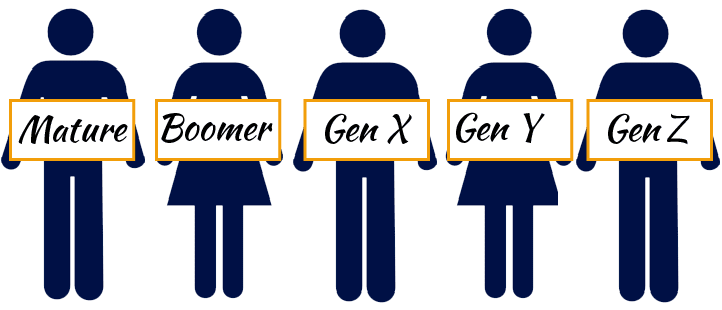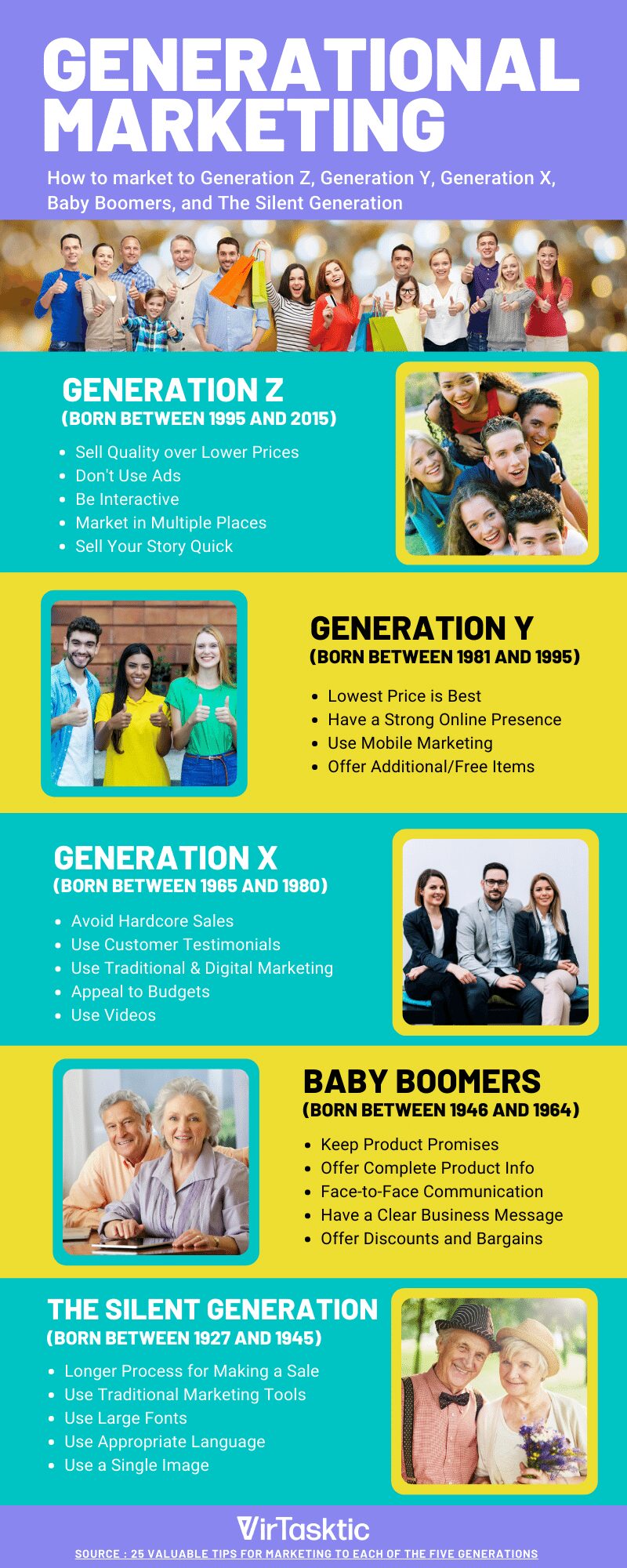The most effective way to grow your business is to customize your marketing strategy to ensure you are not only reaching your target customer demographics but sending them a message that entices them to buy. Today, that is more difficult than ever as we are in a unique commerce situation, with five different generations, who couldn’t be more different, all making purchasing decisions. This is where generational marketing, which is the creation of a marketing plan that uses generational segmentation, comes in to play.
So how do you even begin to fine-tune your marketing message with such a diverse group? We’ve got you covered with these 25 valuable tips on how to market to each of the five generations.

25 Valuable Tips for Getting Generational Marketing Right
Demographics are a major influence in buying behavior. Individuals born at different points of time have distinct preferences in what they value, how they spend their money, and what advertising channels they use. Recognizing these behavioral differences in your customers is essential for maximizing gains from your marketing spends.
Let’s breakdown each of the generations – Generation Z, Generation Y, Generation X, Baby Boomers, and The Silent Generation – to not only see what their unique characteristics are but to figure out the best way to ensure your marketing resonates with them.
Generation Z or Boomlets ‘Born after 1995’

Generation Z, although still not old enough to move about out of mom and dads, make up the largest percentage of the U.S. population (roughly 25%) and by 2020 will most likely account for one-third of the population. With this generation being so large, they are having a huge impact on the market and how families spend their money. According to this survey, in 2015 alone consumers spent over $829 billion on this generation. So if you want to target this generation:
- Don’t worry about having the lowest price. Generation Z looks more for quality and is willing to pay more for something that will last.
- Don’t target them with ads. If their online shopping experience is interrupted by an ad, they will switch their loyalty to another company.
- Be interactive. Gen Zers will be loyal to companies that care about them as a customer and can help them.
- Be in multiple places. This generation can be on their laptop and phone while watching tv, all at the same time and focus on all of it. So show up everywhere they are.
- Sell your story quick (in about 10 seconds or less). This is the attention span of the youngest generation.
Generation Y or Millennials ‘Born between 1981 and 1995’

According to the 2013 report ‘Across the Ages: Generational Impact on Spending’, there are more than 80 million millennials. This young generation that has grown up on technology will soon surpass baby boomers as the largest age group. Millennials are more educated and have more choices than any other generation before them. They are unpredictable, not always brand loyal, and are just as comfortable buying online as they are buying off the rack. If you are targeting this group:
- Opposite of Generation Z, Millennials are looking for the lowest price, with free shipping if applicable.
- Have a strong online presence, including blogs and social media.
- Adopt the latest technology trends to market to this generation.
- Ensure that the promotional e-mailers are compatible for mobile viewing.
- Benefit from their impulsiveness by offering additional items for purchase at the checkout point.
Generation X ‘Born between 1965 and 1980’
 The Gen X demographic covers some 65 million Americans. This generation is an important target market because these individuals are at the peak of their earning and spending years. While they weren’t born in the internet era, the majority use smartphones and regularly access social media. This generation does not want to just follow trends/ styles and is not easily convinced. When marketing to this demographic:
The Gen X demographic covers some 65 million Americans. This generation is an important target market because these individuals are at the peak of their earning and spending years. While they weren’t born in the internet era, the majority use smartphones and regularly access social media. This generation does not want to just follow trends/ styles and is not easily convinced. When marketing to this demographic:
- Avoid hardcore sales tactics.
- Convince them of your business claims with research and customer testimonials.
- Combine traditional marketing efforts with digital promotional tools such as Facebook, email marketing, and online adverts.
- Appeal to money responsibilities. They like to budget, so offer them the deals that can’t refuse.
- Use videos. Most generation Xers are watching videos on social media, youtube, and other channels so take advantage of it!
Baby Boomers ‘Born between 1946 and 1964’

Comprising 76 million consumers, this demographic represents individuals who focused on hard work, individualism, and social activism. They value trust, loyalty, and a sense of community. Many baby boomers are retired or will be retiring soon. According to the Across the Ages report, Boomers are the most likely to be bargain hunting; nearly 28.9 percent of Boomers say they only buy clothing when it’s on sale, a larger share than any other group. Here is what you need to know about this group:
- First and for most, keep your promises to them. When you say your product will fix their problem, follow through.
- They will search for product information online, and through calls and emails.
- However, they place higher faith in face-to-face communication.
- They would be interested in knowing what your business stands for.
- Discounts and bargain deals will appeal more to this demographic than any other.
The Mature or Silent Generation ‘Born between 1927 and 1945’

Also known as “Traditionalists,” this category has 50 million consumers. This generation displayed tremendous resolve to overcome the impact of the Great Depression and World War II. They seek value for money, comfort, and a sense of belonging. Many of them are active seniors and do not like to be regarded as ‘old or dependent’. Here’s what you need to know for marketing to this group:
- They are the least likely to make an impulsive purchase.
- Target them with traditional marketing tools such as flyers, newsletters, and postcards but keep in mind that some of them will use the internet to search for information.
- The promotional material should be in a larger font for ease of reading.
- Use grammar and language that they will appreciate.
- Use a single image (one that conveys emotions) rather than a collage.

Customizing marketing campaigns as per customer demographics is one way to appeal to your customers. As a smaller business, every customer contact offers you the unique opportunity to ask valuable customer research questions like “Have you tried this product before?”, “Did you like the product?”, and “When do you use this product the most?” Knowing more about your customers will help you design products /services attuned to their needs and lifestyle choices.
Need more great marketing tips or just some small business advice? Head over to the VirTasktic Blog for all the advice you could need. If you can’t find what you are looking for or are interested in growing your small business, make sure you get in contact with us!








